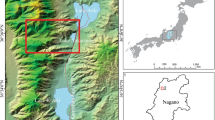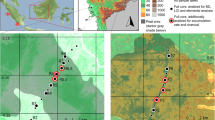Abstract
The wind system responsible for transporting dust onto the Chinese Loess Plateau during the late Miocene and Pliocene is still unknown and recent investigations highlight many controversies. This report aims to investigate spatiotemporal changes in grain-size and sedimentation rate of the Neogene Red Clay deposits in north China and to explore palaeoclimatic changes during the late Miocene and Pliocene, in particular the palaeowind system that transported dust. Samples were collected from eight Red Clay sections on the Loess Plateau. Measurement and analysis show that there is a clear southward decrease in the mean grain-size index and in the coarse particle fraction (>20 ì m). At Jiaxian site on the northern Loess Plateau, the average mean grain-size is around 20 ì m, while at Lantian site in the south, the mean is around 9 ì m. The coarse particle fraction >20 ì m makes up 24.4% and 5.6%, at the two sites respectively. This distinct diversity of grain-size in the aeolian Red Clay deposit between the north and south indicate that the palaeodust was transported mainly by northerly low-level winds. The grain-size variations in the Red Clay deposits can also be divided into three stages (the lower, the middle and the upper interval): grain-size of the lower stage is significantly coarser than that of the middle stage, but finer than that of the upper stage. As a consequence, the intensity of pa-laeowind and desiccation of the dust source region during the late Miocene and Pliocene can be divided into three stages: 6.2-5.4 Ma, 5.4-3.5 Ma and 3.5-2.6 Ma. Strength of the palaeowind during the middle stage (5.4-3.5 Ma) is weaker than that of the previous and subsequent stages and the intensity of palaeowind during the latest stage (3.5-2.6 Ma) is stronger than that of the early time (6.2-5.4 Ma). Variations in the sedimentation rate of the Red Clay deposit can also be divided into three stages: the earlier, the middle and the later interval. The sedimentation rate of the earlier stage is higher than during the middle stage, but lower than during the later one. This is a clear indicator of changes in the palaeowind intensity and aridity in the dust source region and may be linked with global ice volume changes during the late Miocene and the Pliocene.
Similar content being viewed by others
References
Zhao, J. B., The study on the red soil of the Neocene in Xi’an and Baode of Shanxi, Acta Sedimentological Sinica (in Chinese), 1989, 7(3): 113–120.
Zhu, R. X., Pan, Y. X., Ding, Z. L., Magnetic property of “Red Clay”, Quaternary Sciences (in Chinese), 1996, 3: 232–238.
Ding, Z. L., Sun, J. M., Yang, S. L. et al., Magnetostratigraphy and grain size record of a thick “Red Clay”-loess sequence at Lingtai, the Chinese Loess Plateau, Quaternary Science (in Chi-nese), 1998, 1: 86–94.
Zhang, Y. X., Xue, X. X., Taphonomic characteristics of Long-jiagou Hipparion Fauna and genesis of ‘hipparion red Clay’ in Wudu Country, Gansu Province, Chinese Science Bulletin, 1996, 41(3): 238–241.
Sun, D.H., Liu, T. S., Chen, M.Y. et al., Magnetostratigraphy and paleoclimate of red clay sequences from Chinese Loess Plateau, Science in China, Series D, 1997, 40(4): 337–343.
Sun, D. H., Shaw, J., An, Z. S. et al., Magnetostratigraphy and pa-leoclimatic interpretation of continuous 7.2 Ma Late Cenozoic eolian sediments from the Chinese Loess Plateau, Geophysical Research Letters, 1998, 25(1): 85–88.
An, Z. S., Wang, S. M., Wu, X. H. et al., Eolian evidence from the Chinese Loess Plateau: the onset of the late Cenozoic Great Gla-ciation in the northern hemisphere and Qinghai-Xizang Plateau uplift forcing, Science in China, Series D, 1999, 32(3): 258–271.
Lu, H. Y., An, Z. S., Comparison of grain-size distribution of “Red Clay” and loess-paleosol deposits in Chinese Loess Plateau, Acta Sedimentological Sinica (in Chinese), 1999, 17(2): 226–232.
Miao, X. D., Sun, Y. B., Lu, H. Y., Spatial variation of grain size of the late Pliocene “Red Clay”, Chinese Loess Plateau, Acta Sedimentological Sinica (in Chinese), 2001, 19(2): 182–185.
Liu, X. M., An, Z. S., Tim, R. et al., Magnetic properties of the Tertiary red clay from Gansu Province, China and its paleocli-matic significance, Science in China, Series D, 2001, 44(7): 635–652.
Lu, H. Y., Vandenberche, J., An, Z. S., Aeolion origin and palaeo-climatic implications of the “Red Clay” (north China) as evi-denced by grain-size distribution, Journal of Quaternary Science, 2001, 16(1): 89–97.
Guo, Z. T., Peng, S. Z., Hao, Q. Z. et al., Origin of the Mio-cene- Pliocene Red- Earth Formation at Xifeng in Northern China and implications for paleoenvironments, Palaeogeography, Pa-laeoclimatology, Palaeoecology, 2001, 170: 11–26.
Guo, Z. T., Ruddiman, W. F., Hao, Q. Z. et al., Onset of Asian de-sertifications by 22 Ma ago inferred from loess deposits in China, Nature, 2002, 416: 159–163.
Ding, Z. L., Rutter, N. W., Sun, J. M. et al., Re-arrangement of atmospheric circulation at about 2.6 Ma over northern China: evidence from grain size records of loess-palaeosol and “Red Clay” sequences, Quaternary Science Review, 2000, 19: 547–558.
Chen, D. L., The features of grain-size distribution and geological significances for hipparion red beds, Northwest Geoscience (in Chinese), 1996, 17(2): 1–5.
Vandenberghe, J., Lu, H. Y., Sun, D. H. et al., The late Miocene and Pliocene climate in East Asia as recorded by grain size and magnetic susceptibility of the “Red Clay” deposits (Chinese Loess Plateau), Palaeogeography, Palaeoclimatology, Palaeoecology, 2004, 204: 239–255.
Liu, T. S. et al., Loess and the Environment, Beijing: China Ocean Press, 1985, 1–251.
Lv, L. Q., Fang, X. M., Joseph, A. Mason et al., The evolution of coupling of Asian winter monsoon and high latitude climate of northern hemisphere-Grain evidence from 8.1 Ma loess-red clay sequence on the Chinese central Loess Plateau, Science in China, Series D, 2001, 44(Supp.): 185–192.
Sun, D. H., An, Z. S., Show, J. et al., Magnetostratigraphy and paleoclimate significance of Late Tertiary Aeolian sequence in the Loess Plateau of China, Geophysical Research Letters, 1998b, 25: 85–88.
Qiang, X. K., Li, Z. X., Powell, C., McA et al., Magnetostrrati-graphic record of the late Miocene onset of the East Asian mon-soon, and Pliocene uplift of northern Tibet, Earth and Planetary Science Letters, 2001, 187: 83–93.
Cande, S. C., Kent, D. V., Revised calibration of the geomagnetic polarity timescale for the Late Cretaceous and Cenozoic, Journal of Geophysical Research, 1995, 100: 6039–6095.
Lu, H. Y., Miao, X. D., Sun, Y. B., Pretreatment methods and their influences on grain-size measurement of aeolian “Red Clay” in north China, Marine Geology & Quaternary Geology (in Chinese), 2002, 22(3): 129–135.
Lu, H. Y., An, Z. S., Paleoclimatic significance of grain size of. loess-paleosol deposit in Chinese Loess Plateau, Science in China, Series D, 1998, 41(6): 626–631.
Konert, M., Vandenberghe, J., Comparison of laser grain size analysis with pipette and sieve analysis: a solution for the under-estimation of the clay fraction, Sedimentology, 1997, 44: 523–535.
Yue, L. P., Zhang, Y. X., Hipparion fauna and magnetostratigraphy in Hefeng, Jingle, Shanxi Province, Vertebrata Palasiatica (in Chinese), 1998, 36(1): 76–80.
Xue, X. X., Lu, H. Y., Zhou, J., Paleoclimatic significence of grain-size composition of Neocene red earth at Xunyi, Shaanxi Province, Acta Sedimentological Sinica (in Chinese), 2002, 20(1): 118–123.
Zheng, H. B., An, Z. S., Show, J. et al., Magnetostratigraphical study of Duanjiapo loess section, Quaternary geology and Glable Change (eds. Liu, T. S., An, Z. S. et al.), Part. (in Chinese), Beijing: Science Press, 1992, 44–50.
Zhang, X. Y., An, Z. S., Chen, T. et al., Late Quaternary records of the atmospheric input of eolian dust to the center of the Chinese Loess Plateau, Quaternary Research, 1999, 41: 35–43.
Yang, J. C., Zhao, S. S., Yuan, B.Y. et al., Landform and Its Evo-lution in China, Beijing: Ocean Press, 1993, 1–274.
Huang, C. Y., Soil Science (in Chinese), Beijing: Agricultural Press, 2000, 21–31.
Sun, Y. B., Zhou, J., Lu, H. Y. et al., Modification to the grain size distribution of original eolian dust by weathering and pedogenic process, Journal of Desert Research (in Chinese), 2002, 22(1): 16–20.
Sun, D. H., Lu, H. Y., Rea, D. et al., Bimodal grain-size distribu-tion of Chinese loess and its palaeoclimatic implication, Acta Sedimentologica Sinica (in Chinese), 2000, 18: 327–335.
Chen, M. Y., The evolution of Chinese aeolian deposits and global aridification, Quaternary Sciences (in Chinese), 1991, 4: 361–372.
Guo, Z. T., Peng, S. Z., Hao, Q. Z. et al., Late Tertiary develop-ment of aridification in northwestern China: link with the arctic ice-sheet formation and Tibetan uplifts, Quaternary Sciences (in Chinese), 1999, 6: 556–567.
Author information
Authors and Affiliations
Corresponding author
Rights and permissions
About this article
Cite this article
Wen, L., Lu, H. & Qiang, X. Changes in grain-size and sedimentation rate of the Neogene Red Clay deposits along the Chinese Loess Plateau and implications for the palaeowind system. Sci. China Ser. D-Earth Sci. 48, 1452–1462 (2005). https://doi.org/10.1360/01yd0558
Received:
Revised:
Issue Date:
DOI: https://doi.org/10.1360/01yd0558




